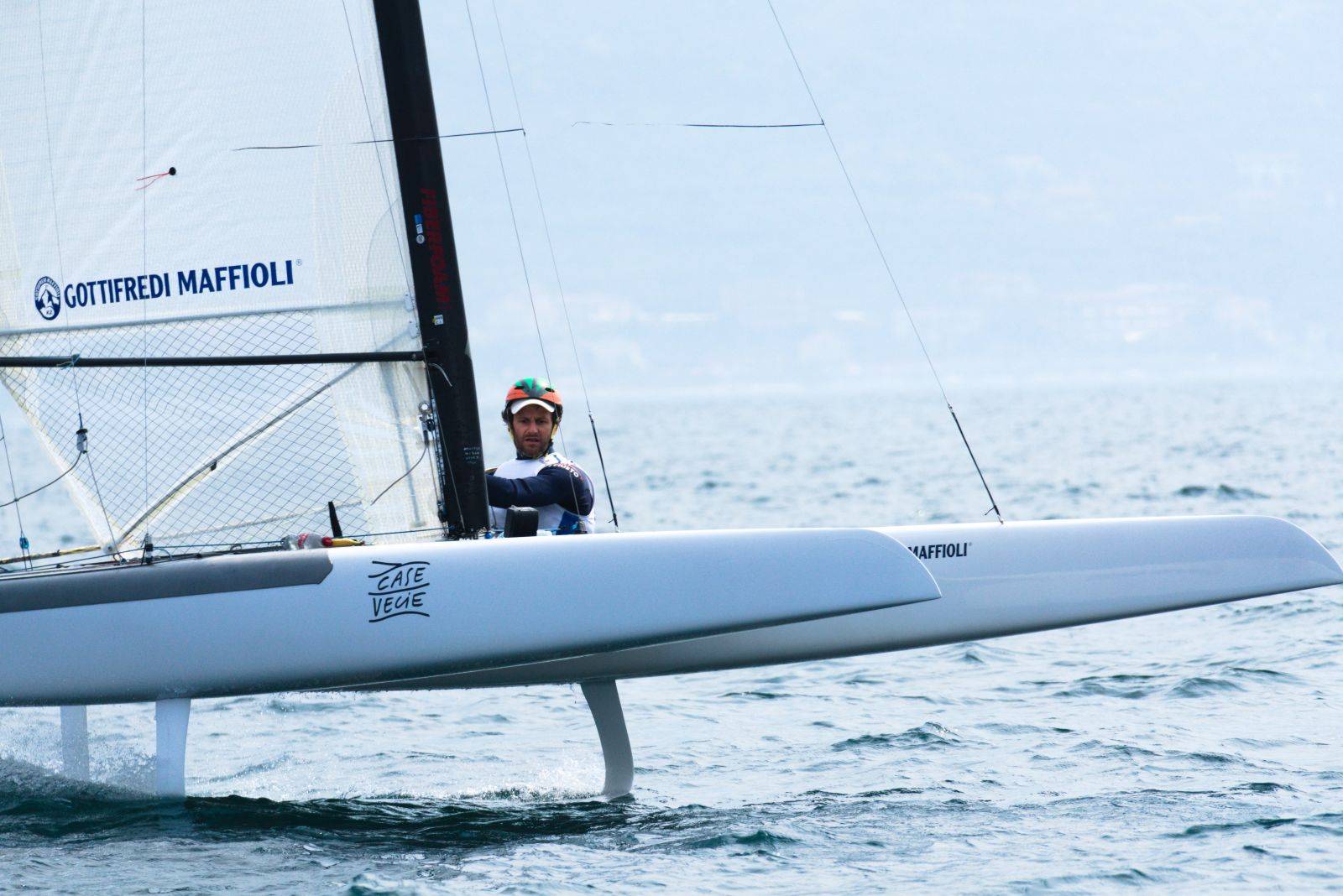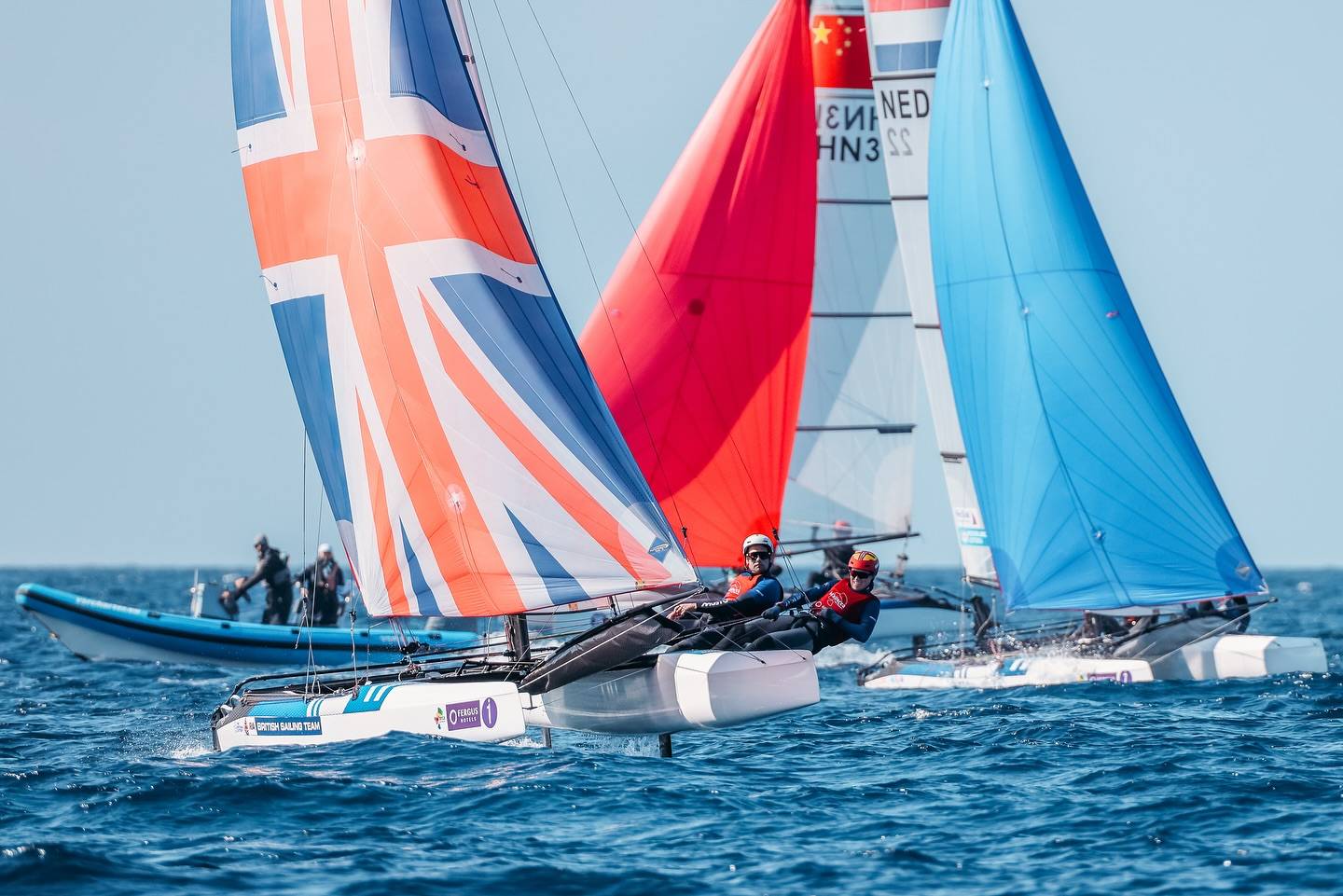Flying Phantom: New OD Class a reality with 20 boats sold.
Image above: Franck Cammas & Francois Gabart. Left and below boat detail gallery by Pierrick Contin –
 Alex Udin sent a press release to announce they sold 20 boats at Paris, and I fired back a Q&A to know how the Production stage will continue next year. This Class will not replace any existing one, it will find as shown by the confirmed orders at Paris Nautique, a niche above the F18 / A-Class / F16 / Nacra 17. The great news are everybody has a Playground of their choice to have fun, expanding possibilities for all. The proof? This project was being reported in CSN only since its inception, and now it has become mainstream. Promoting the sport and helping to the exposure of Catamaran Racing World Wide.
Alex Udin sent a press release to announce they sold 20 boats at Paris, and I fired back a Q&A to know how the Production stage will continue next year. This Class will not replace any existing one, it will find as shown by the confirmed orders at Paris Nautique, a niche above the F18 / A-Class / F16 / Nacra 17. The great news are everybody has a Playground of their choice to have fun, expanding possibilities for all. The proof? This project was being reported in CSN only since its inception, and now it has become mainstream. Promoting the sport and helping to the exposure of Catamaran Racing World Wide.
—————
CSN; How do you feel after 3 years of development and a somehow low start?
 Alex Udin: Launching such an outstanding boat is for sure a challenging project, our goal with Martin Fischer, since the early beginning of the Phantom project was to launch a boat entirely designed for foiling not a kind a convertible F18 or a retrofit kit for an existing boat.
Alex Udin: Launching such an outstanding boat is for sure a challenging project, our goal with Martin Fischer, since the early beginning of the Phantom project was to launch a boat entirely designed for foiling not a kind a convertible F18 or a retrofit kit for an existing boat.
The Flying Phantom is really different from an F18, every parts is designed and optimized for foiling without compromise:
The platform is wider (3m) in order to improve the heeling stability which is crucial to avoid windward heel while you are foiling and trapezing.
The position of the foils has been moved forward in order to have to boat balanced and stable while foiling.
The rig is slightly bigger to compensate the width of the boat which increases the Righting Moment, a high aspect gennaker host on the top of the mast replaces the spinnaker which would not be adapted for the very narrow Apparent Wind Angle while foiling.
The rudder castings are especially designed to
hold the high loads of the T rudders, the blade is moving in a vertical motion inside the cassette in order to be able launch the boat from a beach with waves. The traditional rotary devices are not reliable for T rudders, you cannot put the rudders down with the elevator while you are going forward and if the rudders pops out at hi speed it is like pulling the handbrake on the highway…
The structure of the hulls is designed to withstand to hi stress while the boat is standing on the tip of the foils and rudders, the transoms are bullet proof and the hull are reinforced in the foil case areas.
People might think 3 years is long but it is pretty short to make such a sophisticated boat as simple as possible for the club sailors. Without the help of Franck Cammas and his entire team, Guillaume Verdier, Martin Fischer, Loîc Dorez, Pierre Tissier, Stephane Chatel, Olivier Mainguy it would have taken much longer to have such an accomplished boat ready to foil out of the box.
At the end 6 generations of foils and 3 types of rudders were designed by Guillaume Verdier, Martin Fischer and tested on the Flying Phantom before we designed with Martin the final version for the production boat.
– How hard will be to adapt for current experienced racing catsailors from the F18/A-Class/F/H16/Tornado etc
AU: The handling of the boat is very similar to any beach cat, you just need to adjust the Rake (angle of attack) of the foils according to the speed range, you add more rake while you sail upwind because you sail slower and as soon as you bare away and you accelerate you reduce the Rake of the foils. The trimming is pretty intuitive, as soon as you have the right setting you have a steady flight without changing the rake continuously. Charles Hainneville which is a French F18 sailor, sailed the boat 1 month ago for the first time, after 5 minutes he was fully foiling, that would not be possible on a Moth…
In strong wind with waves, you can reduce the rake of the foils in order to not fully foil and sail it like a more conventional cat with curved foils lifting only a part of the displacement of the boat.
– What about multihull newbies?
AU. This boat is not for beginner sailors, it is much faster than any other beach cat, nether the less if you are experienced you can easily sail the boat in 6 to 12 knots of wind because it a very stable unlike a skiff or a Moth, in the stronger breeze the boat is really fast and you have to get more reactive and used to the speed.
– When do you think you’ll have first boats delivered?
We have actually sold 20 boats, the first batch of boats will be delivered in April, a second batch in May, a third in June and so on.
– You will need a strong service for these boats, how are you going to manage customer service, are you growing the company structure?
AU: We produce and sell direct upon order by necessity. Our production cost are much higher than our competitors due to the use of advanced materials (full carbon honey comb hulls) and manufacturing processes (rudders, foils and mast build of carbon prepreg cured in autoclave) but we guarantee to provide our most valued customers efficient and high quality services both today and in the future. The company Phantom International has been created to run separately the boat business in order to supply the best service to our customers with a larger structure.
Gurvan Bontemps (F18 2013 French champion and 5th at the last F18 World) is joining our team. I am working in close collaboration with him since nearly 10 years on the sails, he has been really involved in the Flying Phantom project this year being part of the sailing team with Franck Cammas and Louis Viat. Gurvan is now working with us and will sail the F18 season on the Phantom and some of the major events on the Flying Phantom.
– Goal for Nr of boats for end of 2014?
AU: We are having a big demand from some of the most renowned AC teams but also from club sailors all around the world. Rather than giving some hypothetic numbers our main goal is to create a worldwide One Design fleet with a European and American tour in some nice, windy and warm venues.
– The F18 model will continue to be offered ? Any mod /update?
AU: Yes sure,we are constantly improving the F18 Phantom, testing several sail designs and configurations, we have also been testing several gibing center boards devices like the one used on François Gabart.
We always try to make the boat faster and easier to sail.
– To me it was key how Cammas had no issues with the C-Class in 5-6knots, that was an impressive performance. Wind range the future FP circuit might race with ?
AU: The Flying Phantom take off from 6-7 knots of wind downwind and reaching and from 10 knots upwind, a range between 5 and 25 knots would make very exiting races.
– I always remember when I asked you in early 2010, if you really thought you could win the World Title with Backes-Jarlegan in such a short time, and you said yes. That was quite an accomplishment. Later
Olivier got the title with Vandame at LA with your new F18. You launched the F Phantom also , and now is a solid reality.
What is next? What about your dream in participating on the ACup?
AU: I love challenging projects, I founded Sail Innovation 2003 with the ambition to be the most innovative company in the sail making industry.
After 10 years, Sail Innovation and Phantom Int are surrounded by some of the best sailors in the world.
All these achievements would not have been possible without a great team.
I would like to thank Franck Cammas and his team for their support on the Flying Phantom, I wish them all the best for their America’s Cup project, I am really convinced Franck is able to win this thing.
I would also like to thank all the sailors surrounding me for several years like Olivier Backes, Matthieu Vandame, François Gabart, Arnaud Jarlegan, Hugh Styles and Richard Masson, the Phantom project would not have been a success without them.
—Ends—
Contact Alex Udin at www.phantom-international.com
Copyright Catsailingnews.com
Images below by Pierrick Contin.
 |
 |
 |
 |
 |
 |
 |
 |
 |
 |
 |
 |
 |
 |
 |
 |
 |
 |






























I just heard that my great sailing friend and former CEO of Hobiecat Europe has passed. May The endless oceans…
...Report was sent by an F18 Sailor, if you want Hobies reported send your own, we'll publish as usual. Cheers.
Looks like in your report the Hobies are not really present. Suggest to rewrite the article.
Thanks for the great report Wik. Great battle.
If I correctly read the results the overall winner this year is a Hobie16